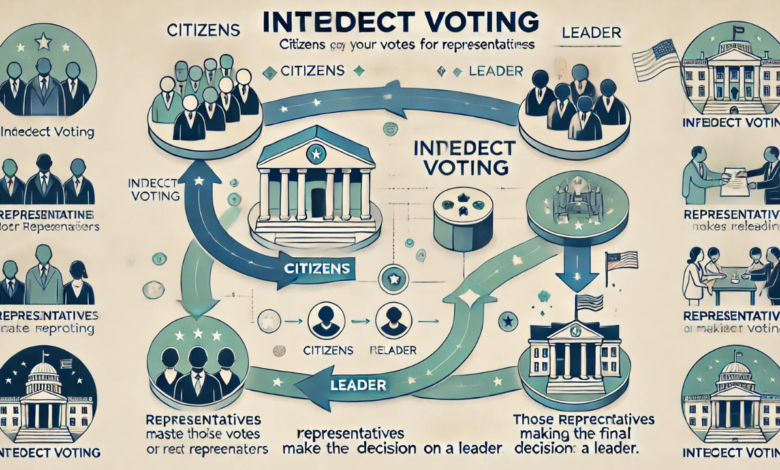Indirect Voting for Dummies: A Simple Guide to Understanding Indirect Voting Systems

In politics, how we elect leaders is crucial to shaping the future of a nation. While some countries use direct voting systems, others rely on indirect voting methods to select their representatives. If you’re new to the concept or find it confusing, don’t worry—this guide is here to break it down for you in the simplest terms. We’ll explore indirect voting, its use, and where it plays a significant role in democratic processes. By the end of this article, you’ll clearly understand indirect voting and how it impacts the governance of different countries.
What is Indirect Voting?
Indirect voting is a method of election where voters do not directly choose the individual who will hold office. Instead, they elect representatives who then select the officeholder on their behalf. This system is often employed in large and complex democracies where direct voting for every position might be impractical or inefficient.
For example, in the United States, the President is not directly elected by the people. Instead, citizens vote for electors in the Electoral College, who then vote for the President. This is a classic example of an indirect voting system.
How Does Indirect Voting Work?
The mechanics of indirect voting can vary depending on the specific system in place. However, the general process usually involves several steps:
- Election of Representatives: Citizens vote for a group of representatives, often called electors or delegates. These individuals are usually aligned with specific political parties or candidates.
- Decision by Representatives: The elected representatives then cast their votes for the officeholder, such as a president, prime minister, or member of a legislative body.
- Final Selection: The candidate who receives the majority of votes from the representatives is declared the winner and assumes the office.
This process allows for a layer of decision-making between the general public and the final selection of leaders, which can be advantageous in specific political contexts.
Why is Indirect Voting Used?
Indirect voting is employed for several reasons, each offering unique benefits to the democratic process:
- Representation of Diverse Interests: In large countries with diverse populations, indirect voting allows for a more balanced representation of various regional, cultural, and economic interests. Representatives can act as intermediaries who understand their constituents’ specific needs.
- Stability in Government: Indirect voting can contribute to political stability by preventing the election of leaders based solely on populism or fleeting trends. Representatives may have a deeper understanding of the political landscape and choose candidates better suited for long-term governance.
- Protection of Minority Rights: In some cases, indirect voting can protect the interests of minority groups by ensuring that their voices are heard through elected representatives rather than being drowned out in a direct vote.
- Efficiency in Large Democracies: Direct voting for every position can be logistically challenging for countries with large populations. Indirect voting streamlines the process by reducing the number of elections and focusing on critical representatives who make the final decisions.
Examples of Indirect Voting Systems
Indirect voting systems are used in various forms around the world. Here are some notable examples:
- The United States Electoral College: As mentioned earlier, the U.S. President is elected through an indirect system known as the Electoral College. Citizens choose electors who subsequently vote for the President. Each state has a certain number of electors based on its population. Most states utilize a “winner-takes-all” strategy, whereby the candidate who won the popular vote in that state receives all its electoral votes.
- India’s Parliamentary System: In India, the Prime Minister is not directly elected by the people. Instead, citizens vote for members of the Lok Sabha (the lower house of Parliament). The leader of the majority party or coalition in the Lok Sabha is The President, who selects India’s Prime Minister.
- Germany’s Federal Convention: The President of Germany is elected by the Federal Convention, composed of members of the Bundestag (the federal parliament) and state representatives. This indirect system ensures that federal and state interests are considered in the election of the President.
- The Holy See (Vatican City): The Pope, the head of the Roman Catholic Church, is elected indirectly by the College of Cardinals. These cardinals are selected worldwide and vote in a conclave to choose the new Pope.
Pros and Cons of Indirect Voting
Like any electoral system, indirect voting has advantages and disadvantages. Understanding these can help you appreciate why some countries choose this method over direct voting.
Pros:
- Balanced Representation: Indirect voting can lead to a more balanced representation of different regions, communities, and interest groups within a country.
- Informed Decision-Making: Representatives may better understand the candidates and their policies, leading to more informed decisions.
- Political Stability: By filtering popular sentiment through representatives, indirect voting can help prevent sudden shifts in political power based on temporary trends.
- Minority Protection: Indirect systems can give minority groups a stronger voice in the electoral process.
Cons:
- Lack of Direct Accountability: Since voters do not directly choose the officeholder, there may be a perceived lack of accountability.
- Complexity: Indirect voting systems can be complex and challenging for the average voter to understand, leading to potential disengagement.
- Potential for Manipulation: In some cases, representatives may be influenced by factors other than the people’s will, leading to concerns about fairness and transparency.
- Dilution of Popular Will: The indirect nature of the process can dilute the impact of the popular vote, leading to outcomes that may only partially reflect the electorate’s preferences.
Indirect Voting vs. Direct Voting
Comparing indirect voting with direct voting is helpful for further understanding its significance. In a direct voting system, voters cast their ballots directly for the candidates they want to hold office. This method is straightforward and ensures that the majority’s will is directly reflected in the outcome.
However, direct voting also has its challenges. In large democracies, direct voting can lead to the “tyranny of the majority,” where the majority overshadows the interests of smaller or minority groups. Additionally, direct voting can be more susceptible to populism, where candidates appeal to short-term emotions rather than long-term stability.
Indirect voting addresses some of these issues by introducing a representation layer, allowing for more considered and balanced decision-making. However, it also introduces complexity and potential disconnects between voters and the final officeholder.
Conclusion
Indirect voting systems play a vital role in the governance of many countries, providing a balance between representation, stability, and efficiency. While it may initially seem complex, understanding the mechanics and reasoning behind indirect voting can help you appreciate its value in specific political contexts.
FAQs about Indirect Voting for Dummies
What is the significant difference between direct and indirect voting?
Direct voting allows citizens to vote directly for the officeholder, while indirect voting involves electing representatives who then choose the officeholder on behalf of the voters.
Why do some countries use indirect voting?
Indirect voting is used for various reasons, including better representation of diverse interests, political stability, and efficiency in large democracies.
Can indirect voting lead to unfair election outcomes?
While indirect voting can sometimes lead to outcomes that differ from the popular vote, it is designed to balance various interests and prevent the dominance of any one group.
What are some examples of indirect voting systems?
Examples include the U.S. Electoral College, India’s parliamentary system, and the election of the Pope by the College of Cardinals.
Is indirect voting more complex than direct voting?
Yes, indirect voting systems can be more complex and may require voters to understand multiple layers of decision-making. However, this complexity can also lead to more balanced and stable governance.
You May Also Read: Division: A Deep Dive into the Calculation of 1664.60/2




